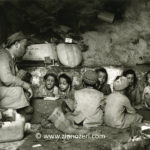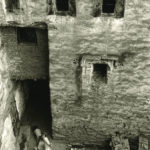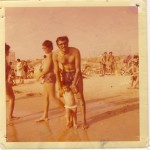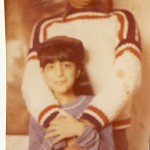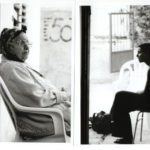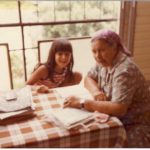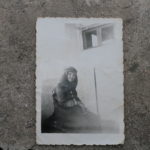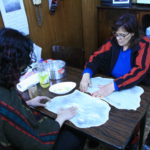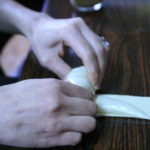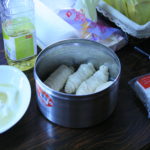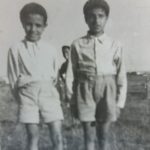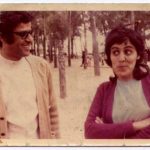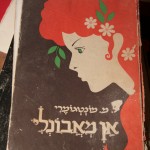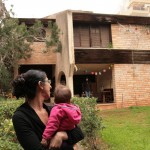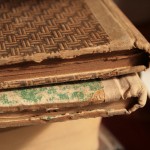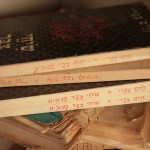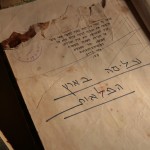Photos
Yemen
In the acknowledgements for The Art of Leaving I mention Zion Ozeri, a wonderful Israeli photographer whose photos of Haidan-a-Sham remain the only ones I’ve ever seen. I remember the day I came across these photos online, about ten years ago. I had been Googling Haidan-a-Sham, the village where my grandmother was born, but I might have been spelling it wrong because I found absolutely nothing. Just when I started to suspect it didn’t exist, I tried a different spelling and found the photo you see in the middle. Turns out, Ozeri took the photos on a trip to Yemen in 1992. Not many Israelis have made it to Yemen (since Yemen has no diplomatic relationship with Israel you cannot visit it with an Israeli passport) so this was a big deal. I later found out Ozeri was related to us by marriage, which totally proves my point that all Yemenis are related unless proven otherwise! I was blown away by the images. They showed Young Jewish boys studying the torah in a cave, their simonim—the side curls that distinguished them from the Muslims—framing their faces. Barefoot girls smiled shyly at the camera, their heads covered in the traditional gurgush, a hood that tied under the chins. In the background, mud houses sat at the feet of giant mountains. For the first time, I could situate my grandmother’s childhood in a tangible place. I had always pictured my ancestors living underneath palm trees on sandy dunes that rolled softly towards the Red Sea. I imagined intense heat and a sultry breeze. As it turned out, we were mountain people. The nights in Haidan were cold; sometimes it even snowed. Families slept together by the fire to keep warm. I revisited in my mind all the times I had excused my pathetic intolerance for cold. “My family is from the desert,” I said. “It’s not in my genes.”
I later met Zion and his lovely wife in New York and purchased his stunning book, The Jews of Yemen: The Last Generation. You can view many of his photos (from Yemen, Israel, and other places in the world) on his website. This is just a taste.
Family Photos
Not just family, but some food too! You’ll find some photos of staple Yemeni dishes my mom makes, and which I describe in my essay, “Yemeni Soup and Other Recipes,” that appears in The Art of Leaving. To view full size and read the captions, click on each image.
“If I Forget You”
In the essay “If I Forget You,” I wrote about the books I found at my family’s house and had to discard of before the demolition. While I was packing the books away, I took some photos of them, since I find old books to be endlessly photogenic. I also included here photos of the house, of my childhood room (with the writing I scribbled on its walls before I left, as described in the essay), and my final farewell to it.
Links
Essays and Videos
- In “A Simple Girl,” I quote the late Dr. Vickie Shiran who wrote about the North African name – which later became a derogatory slur – Freha: “I see you, a
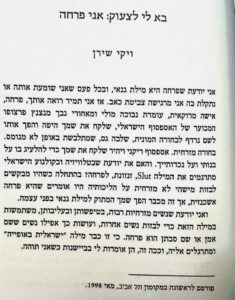 Moroccan woman standing embarrassed, and behind your back the shimmering ugly face of the Israeli mob who took your beautiful name and made it synonymous with a vulgar woman whose heart is rough . . . Took your name and used it to mock my daughters and your granddaughters.” The essay appeared in an op-ed Shiran published in Tel Aviv Magazine in 1988 and in the book, To My Sister, Mizrahi Feminist Politics. Unfortunately, neither the essay nor the book were translated into English. But you can watch the movie about Shiran, Breaking Walls, which has English subtitles, on YouTube.
Moroccan woman standing embarrassed, and behind your back the shimmering ugly face of the Israeli mob who took your beautiful name and made it synonymous with a vulgar woman whose heart is rough . . . Took your name and used it to mock my daughters and your granddaughters.” The essay appeared in an op-ed Shiran published in Tel Aviv Magazine in 1988 and in the book, To My Sister, Mizrahi Feminist Politics. Unfortunately, neither the essay nor the book were translated into English. But you can watch the movie about Shiran, Breaking Walls, which has English subtitles, on YouTube. - In “Yemeni Soup and Other Recipes,” I mention a fundraising video from the fifties that was meant to highlight the work of Moetzet HaPoalot (Working Women’s Council). In the film, the narrator says Yemeni women are “fruitful and multiply but they need proper instructions”—instructions given by Ashkenazi women, as the film demonstrates. The video was titled Bederech Halev (The Way of the Heart). This specific excerpt of the video is available here, on TV director Uri Rosenwaks’ Facebook page.
- Yonit Naaman’s amazing essay “Everyone Knows Yemenites Are Great In Bed,” was the inspiration for “A Simple Girl.” It’s a must-read. Yonit and I are second cousins and heart-sisters. She is the granddaughter of Saida, my grandmother’s twin sister, as told in the book.
Yemenite Children Affair
- In “Not for the Faint-hearted,” I mentioned the Yemenite Children Affair (more accurately the Yemenite, Mizrahi, and Balkani Children Affair) as a trauma that shaped Jewish Yemeni history. However, expanding on this devastating topic was beyond the scope of this book. If you’d like to know more, the only book written in English on the topic is Israeli Media and the Framing of Internal Conflict: The Yemenite Babies Affair by S. Madmoni-Gerber (Palgrave Macmillan, 2009).
- In Israel, the Amram Association has been doing amazing work collecting survivors’ testimonies and fighting for justice and recognition. You can find and support them online.
- You can also watch the powerful, highly recommended web series Neviim docu shorts: Operation Amram on YouTube for interviews with survivors and activists. (English subtitles are available.) Read about the series and its creators here.
Playlist
I always wanted to create a playlist for my book! It is an opportunity for me to showcase some Yemeni Israeli musicians and to celebrate the beautiful rhythms and sounds of Yemeni music, both traditional and contemporary. I hope this short playlist will make you look up these amazing artists and follow their work.
Ofra Haza, Im Ninalu
I wrote about Ofra Haza and my love for her in “A Simple Girl.” The essay first appeared in the 2018 issue of Paper Brigade. Reviewing the issue for Tablet, Liel Leibovitz praised this “touching tribute to the late, great Israeli pop star Ofra Haza … the piece is a gorgeous meditation on what it means to try and fit in when practically nothing in the culture looks or feels like you, and how one iconic singer can inspire a personal and artistic transformation.” “Im Ninalu” is a piyut written by 17th-century Jewish Yemeni poet Rabbi Shalom Shabazi. The song is a devotional song (so, a part of the Men’s Songs tradition) written in Hebrew and sang in Yemeni accent and intonation. This remix was and included on Ofra’s 1984 album Yemenite Songs,
A-WA Habib Galbi
I am obsessed with this band! The three Israeli Yemeni sisters from a small town in the desert made waves with their first single “Habib Galbi” (“Love of My Heart”), which became an instant world hit, with its Yemenite traditional music mixed with hip-hop and electronic music. What I admire about A-WA is that they took a very specific tradition, that of the Yemeni Women’s Songs, (which I’ve been studying for the past few years, with the support of the Ontario Arts Council and The Chalmers Family Fund) and revived it. “Habib Galbi” isn’t new. It is an ancient song I’d heard in Yemeni weddings my whole life. A-WA just made it current and funky!
A-WA – Hana Mash Hu Al Yaman
In their second album, A-WA did something even more revolutionary, by writing new songs in the age-old tradition of the Yemeni women’s songs. And their newest song, written in honour of their grandmother, captures the spirit of the women’s songs so well. The women’s songs expressed pain, heartaches, and longings, but they were also a form of protest, a chance for the women to speak their truth, a poetry of dissent. Here A-WA gives that old tradition a new spin, both in style and in subject matter. They write about the struggles their grandmother experienced upon coming to Israel from Yemen, and even mention the case of the kidnapped children (“Don’t let them take your daughter.”) It’s amazing. I’m in awe of these young women.
Um Min Al Yaman – Yemen Blues
Another band that tries to revive old Yemeni music is Yemen Blues. The band was founded by Ravid Kahalani – Singer / Composer / Producer & Performer. He was born in 1978 to a Jewish Yemeni family known for its musical talent. As a child Kahalani was taught traditional Yemeni chants and was sent to religious courses with a Yemeni rabbi. The music he writes music is a mixture of Yemeni and West African influences, and fuses funk, soul, blues and jazz. I love many of the band’s songs but I chose this one for the infectious rhythm and for the lyrics: “My mother is from Yemen. ”
Yemen Women Songs: Gulaza
I recently stumbled upon this band on the radio and loved their sound so much! Gulaza is headed by Igal Mizrahi, an Israeli man of Yemeni heritage who is singing the Yemeni women’s songs. His rendition of the songs is just beautiful.
Gila Beshari – Gul Lilhbib
I mention (briefly) in the book, that at some point I started studying The Women’s Songs. In fact, I was lucky enough to be awarded a Chalmers Arts fellowship and a Chalmers Professional Development grant by the Ontario Arts Council and The Chalmers Family Fund to study the tradition. During a trip to Israel, I met Gila Beshari, one of the greatest Yemeni singers in Israel, who’s been trained in both women’s and men’s songs. Gila has agreed to teach me some of the women’s songs. She provided me with the Yemeni lyrics written phonetically in Hebrew, as well as the translation and the context of each song. Once I started singing, my emotional engagement with the spoken poetry of my community has changed radically. I’m grateful to the Chalmers Family Fund and the Ontario Arts Council for their generous support, and I’m immensely grateful to the amazing Gila for agreeing to be my teacher.
Bracha Cohen, Miskin Ya Nas
A-WA, Yemen Blues, and the others I mentioned have been performing around the world and bringing attention to the Jewish Yemeni musical tradition. But in Israel, there are many other Yemeni musicians that are singing and performing traditional music. I wanted to include one of them, Bracha Cohen, who’s well known amongst older Yemeni folks although not so much amongst the rest of the Israeli population. In fact, there’s very little information about her on the web. Here’s another video of Bracha singing live and drumming while dressed in a traditional Yemeni outfit.
“A Simple Girl” – Music
In “A Simple Girl,” I mention several of Ofra Haza’s songs. I included one of her Yemeni songs in the playlist above, but I don’t think this page would be complete without a video of her 1983 Eurovision performance, “Hai,” (which won second place!) and, of course, “The Freha Song,” which I write about in the essay. This, below, is the scene as performed in the 1979 movie Shlager (The Hit).

